The spider silk fabric market is projected to grow from USD 74.1 million in 2025 to USD 158.5 million by 2035, reflecting a CAGR of 7.9%. Market dynamics suggest expansion will be fueled by the rising commercial viability of lab-engineered spider silk, coupled with growing applications across textiles, defense, and healthcare. The material’s hallmark properties, light weight, tensile strength, and elasticity, make it highly attractive for performance-driven industries. However, growth will remain closely tied to advancements in cost-efficient production and the ability to scale fermentation and protein-engineering platforms beyond pilot levels.
Regional CAGR forecasts highlight a divergent outlook. North America is positioned for steady growth due to its biotech innovation hubs and partnerships between startups and apparel or defense players. Europe is expected to show strong momentum as sustainability policies favor biodegradable and high-performance fibers in apparel and medical textiles. Asia Pacific is likely to outpace both regions, with Japan, South Korea, and China investing heavily in high-tech fabrics for sportswear, luxury apparel, and industrial textiles. In contrast, Latin America and the Middle East & Africa will show slower progress, limited by infrastructure gaps and lower penetration of specialty fabrics.
Substitution analysis shows that spider silk competes across three fronts. Against synthetic fibers like nylon and polyester, spider silk offers biodegradability and superior mechanical strength but faces challenges in cost and scalability. Compared with natural fibers such as cotton, wool, or conventional silk, spider silk provides unmatched durability and elasticity, though mass adoption in mainstream fashion remains uncertain due to limited supply. When measured against high-performance fibers like Kevlar or carbon fiber, spider silk delivers comparable strength with better flexibility and lighter weight, along with environmental advantages. These trade-offs highlight substitution potential in defense, medical implants, protective clothing, and luxury apparel, while cost keeps it from displacing synthetics in mass-market segments.
Raw material volatility represents a key market constraint. Engineered spider silk proteins are often produced using fermentation systems that rely on agricultural feedstocks such as soy or palm derivatives, as well as energy-intensive bioprocesses. Fluctuations in agricultural yields, trade restrictions, and global energy prices influence production economics. Managing these inputs through diversified sourcing and more efficient bio-reactor designs will be critical for maintaining competitive pricing.
Expansion opportunities are pronounced in emerging markets. Consumer demand for advanced textiles in Asia and Latin America is rising, particularly in personal care, sportswear, and medical applications. Biotech spillovers from adjacent industries such as pharmaceuticals and food processing also support broader acceptance of spider silk materials. With increasing investment in biotechnology and textile innovation, the spider silk fabric market outlook points to steady long-term growth. Success will depend on balancing scalability, cost control, and effective substitution against incumbent fibers.
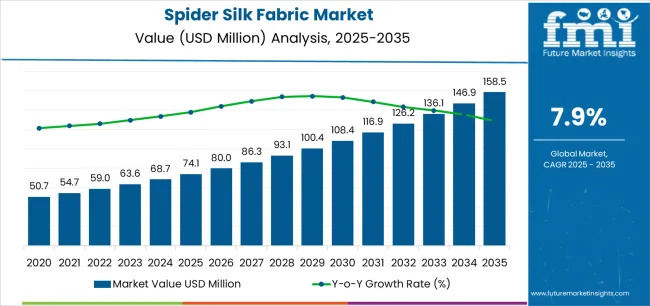
| Period | Primary Revenue Buckets | Share | Notes |
|---|---|---|---|
| Today | Synthetic spider silk products (apparel, technical textiles) | 68% | Laboratory-produced fibers, performance applications |
| Natural spider silk applications | 32% | Limited production, luxury applications | |
| Future (3-5 yrs) | Advanced synthetic systems | 58-62% | Scalable production, engineered properties |
| Military & aerospace applications | 18-22% | High-performance requirements, defense contracts | |
| Medical & healthcare textiles | 12-16% | Biocompatible materials, surgical applications | |
| Luxury apparel & fashion | 8-12% | Premium clothing, sustainable fashion | |
| Industrial applications | 6-10% | Protective equipment, technical fabrics | |
| Research & development services | 3-6% | Custom formulations, material testing |
At-a-Glance Metrics
| Metric | Value |
|---|---|
| Market Value (2025) | USD 74.1 million |
| Market Forecast (2035) | USD 158.5 million |
| Growth Rate | 7.9% CAGR |
| Leading Technology | Synthetic Spider Silk Systems |
| Primary Application | Clothing Segment |
The spider silk fabric market demonstrates strong fundamentals, with synthetic spider silk systems capturing a dominant share through advanced material properties and commercial application optimization. Clothing applications drive primary demand, supported by increasing performance requirements and fashion industry innovation initiatives. Geographic expansion remains concentrated in developed markets with established biotechnology infrastructure, while emerging economies show accelerating adoption rates driven by textile modernization initiatives and rising quality standards.
Primary Classification: The spider silk fabric market segments by product type into natural spider silk and synthetic spider silk, representing the evolution from limited natural harvesting to sophisticated biotechnological production for comprehensive textile optimization.
Secondary Classification: Application segmentation divides the spider silk fabric market into clothing, military, medical, aerospace, and other applications, reflecting distinct requirements for material performance, durability standards, and end-use specifications.
Tertiary Classification: End-use segmentation covers fashion brands, defense contractors, medical device manufacturers, aerospace companies, and research institutions, while distribution channels span direct sales, textile distributors, and specialized material suppliers.
Regional Classification: Geographic distribution covers North America, Latin America, Western Europe, Eastern Europe, East Asia, South Asia Pacific, and Middle East & Africa, with developed markets leading adoption while emerging economies show accelerating growth patterns driven by textile industry modernization programs.
The segmentation structure reveals technology progression from limited natural silk harvesting toward sophisticated synthetic production systems with enhanced scalability and performance capabilities, while application diversity spans from luxury fashion to critical defense operations requiring precision material solutions.
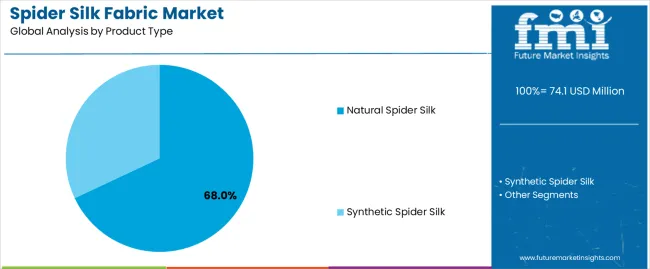
Market Position: Synthetic spider silk systems command the leading position in the spider silk fabric market with 68% market share through advanced production technologies, including scalable manufacturing processes, consistent material properties, and commercial application optimization that enable textile manufacturers to achieve optimal performance outcomes across diverse apparel and technical textile environments.
Value Drivers: The segment benefits from textile industry preference for reliable material systems that provide consistent fiber quality, reduced production constraints, and operational efficiency optimization without requiring natural spider farming infrastructure. Advanced biotechnology features enable automated production systems, quality monitoring, and integration with existing textile equipment, where material performance and production scalability represent critical manufacturing requirements.
Competitive Advantages: Synthetic spider silk systems differentiate through proven production reliability, consistent material characteristics, and integration with automated manufacturing systems that enhance facility effectiveness while maintaining optimal quality standards suitable for diverse commercial and technical applications.
Key market characteristics:
Natural spider silk systems maintain a 32% market position in the spider silk fabric market due to their unique properties and premium positioning advantages. These materials appeal to facilities requiring exclusive textile solutions with exceptional performance profiles for specialized luxury applications. Market growth is driven by premium fashion expansion, emphasizing natural fiber solutions and operational exclusivity through optimized harvesting designs.
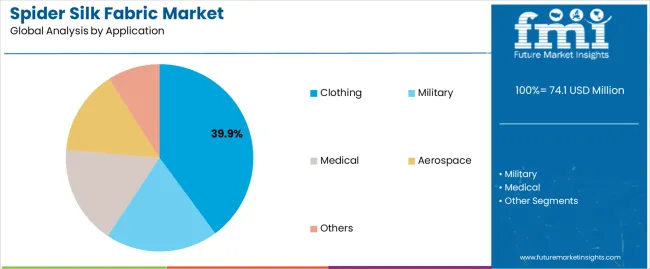
Market Context: Clothing applications show strong growth in the spider silk fabric market with an 8.2% CAGR and a 39.9% industry share, driven by the widespread adoption of high-performance textiles and an increasing focus on fashion innovation, operational cost efficiency, and garment performance initiatives that enhance material effectiveness while maintaining comfort standards.
Appeal Factors: Fashion operators prioritize material reliability, performance consistency, and integration with existing textile infrastructure that enables coordinated production operations across multiple garment lines. The segment benefits from substantial fashion industry investment and innovation programs that emphasize the acquisition of advanced materials for product differentiation and consumer appeal applications.
Growth Drivers: Fashion expansion programs incorporate spider silk materials as premium components for high-end garments, while performance apparel growth increases demand for textile capabilities that comply with durability standards and minimize production complexity.
Market Challenges: Varying consumer requirements and production scale complexity may limit material standardization across different brands or application scenarios.
Application dynamics include:
Military applications capture 22% market share through specialized performance requirements in defense contractors, military equipment manufacturers, and tactical applications. These facilities demand high-strength materials capable of supporting protection requirements while providing reliable performance access and operational durability capabilities.
Medical applications account for 15% market share, including surgical materials, biomedical devices, and healthcare requiring biocompatible textile capabilities for medical optimization and therapeutic effectiveness.
Aerospace applications maintain 8% market share through demanding performance requirements in aircraft manufacturing, space applications, and defense, requiring advanced material capabilities for operational optimization and weight reduction.
Market Context: Fashion Brands dominate the spider silk fabric market with an 8.5% CAGR, reflecting the primary demand source for spider silk fabric technology in apparel applications and product innovation operations.
Business Model Advantages: Fashion Brands provide direct market demand for advanced textile materials, driving product innovation and capacity expansion while maintaining quality control and brand positioning requirements.
Operational Benefits: Fashion Brand applications include product differentiation, premium positioning, and quality assurance that drive consistent demand for silk materials while providing access to latest material technologies.
| Category | Factor | Impact | Why It Matters |
|---|---|---|---|
| Driver | Performance apparel demand & athletic wear growth (strength, comfort, durability) | ★★★★★ | Growing performance textile market requires materials with exceptional strength-to-weight ratios and comfort properties proven effective across athletic applications. |
| Driver | Biotechnology advancement & production scaling (synthetic biology, fermentation) | ★★★★★ | Turns advanced material production from "experimental" to "commercial"; manufacturers that offer scalable production and consistent quality gain competitive advantage. |
| Driver | Luxury fashion market growth & premium positioning (exclusivity, performance) | ★★★★☆ | Luxury fashion brands need unique, high-performance materials; demand for exclusive and superior textile solutions expanding addressable market. |
| Restraint | Production costs & scaling challenges (especially for commercial volumes) | ★★★★☆ | Smaller textile manufacturers defer adoption; increases price sensitivity and slows advanced material adoption in cost-conscious markets. |
| Restraint | Alternative high-performance fiber competition (carbon fiber, advanced synthetics) | ★★★☆☆ | Modern synthetic alternatives offer established supply chains and proven performance, potentially limiting spider silk adoption in traditional applications. |
| Trend | Biotechnology integration & automated production (bioreactors, process optimization) | ★★★★★ | Real-time production monitoring, quality tracking, and process analytics transform operations; automation and biotechnology integration become core value propositions. |
| Trend | Customization & application-specific formulations (military, medical, fashion) | ★★★★☆ | Custom silk properties for specific applications; specialized materials and targeted performance capabilities drive competition toward customization solutions. |
The spider silk fabric market demonstrates varied regional dynamics with Growth Leaders including China (10.7% growth rate) and India (9.9% growth rate) driving expansion through biotechnology advancement initiatives and textile manufacturing development. Steady Performers encompass Germany (9.1% growth rate), Brazil (8.3% growth rate), and developed regions, benefiting from established textile industries and advanced material adoption. Mature Markets feature United States (7.5% growth rate), United Kingdom (6.7% growth rate), and Japan (5.9% growth rate), where biotechnology advancement and regulatory standardization requirements support consistent growth patterns.
Regional synthesis reveals East Asian markets leading adoption through textile expansion and biotechnology development, while North American countries maintain steady expansion supported by material technology advancement and commercial standardization requirements. European markets show strong growth driven by fashion applications and innovation integration trends.
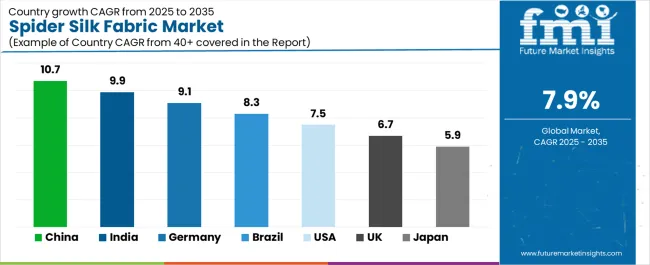
| Region/Country | 2025 to 2035 Growth | How to win | What to watch out |
|---|---|---|---|
| China | 10.7% | Focus on production scaling solutions | Regulatory changes; local competition |
| India | 9.9% | Lead with cost-effective manufacturing | Import restrictions; technology barriers |
| Germany | 9.1% | Provide premium quality materials | Over-regulation; lengthy approvals |
| Brazil | 8.3% | Offer value-oriented production | Currency fluctuations; import duties |
| United States | 7.5% | Push biotechnology integration | FDA compliance costs; scaling challenges |
| United Kingdom | 6.7% | Focus on luxury applications | Brexit impacts; material costs |
| Japan | 5.9% | Emphasize precision manufacturing | Traditional preferences; adoption rates |
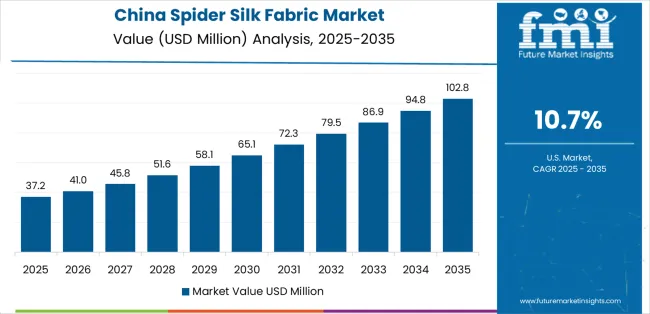
China establishes fastest market growth through aggressive biotechnology development programs and comprehensive textile manufacturing expansion, integrating advanced spider silk production systems as standard components in high-performance textile facilities and commercial manufacturing installations. The country's 10.7% growth rate reflects government initiatives promoting biotechnology infrastructure and domestic material capabilities that mandate the use of advanced silk systems in textile and apparel manufacturing facilities. Growth concentrates in major biotechnology hubs, including Beijing, Shanghai, and Shenzhen, where material technology development showcases integrated production systems that appeal to textile operators seeking advanced material optimization capabilities and commercial applications.
Chinese manufacturers are developing cost-effective silk production solutions that combine domestic biotechnology advantages with advanced material features, including automated production control and enhanced quality capabilities. Distribution channels through textile equipment suppliers and material distributors expand market access, while government support for biotechnology development supports adoption across diverse textile and manufacturing segments.
Strategic Market Indicators:
In Mumbai, Bangalore, and Delhi, textile facilities and apparel manufacturers are implementing advanced spider silk production systems as standard equipment for material optimization and product differentiation applications, driven by increasing government textile investment and biotechnology modernization programs that emphasize the importance of advanced material capabilities. The spider silk fabric market holds a 9.9% growth rate, supported by government textile initiatives and biotechnology development programs that promote advanced material systems for textile and apparel facilities. Indian operators are adopting silk systems that provide consistent material performance and quality features, particularly appealing in urban regions where product differentiation and material excellence represent critical operational requirements.
Market expansion benefits from growing biotechnology capabilities and international technology partnerships that enable domestic production of advanced material systems for textile and apparel applications. Technology adoption follows patterns established in biotechnology equipment, where reliability and performance drive procurement decisions and operational deployment.
Market Intelligence Brief:
Germany's advanced biotechnology market demonstrates sophisticated spider silk deployment with documented material effectiveness in textile applications and manufacturing facilities through integration with existing production systems and manufacturing infrastructure. The country leverages engineering expertise in biotechnology and quality systems integration to maintain a 9.1% growth rate. Manufacturing centers, including Baden-Württemberg, Bavaria, and North Rhine-Westphalia, showcase premium installations where material systems integrate with comprehensive production platforms and facility management systems to optimize manufacturing operations and material effectiveness.
German manufacturers prioritize system precision and EU compliance in material equipment development, creating demand for premium systems with advanced features, including facility monitoring integration and automated quality systems. The spider silk fabric market benefits from established biotechnology infrastructure and a willingness to invest in advanced material technologies that provide long-term operational benefits and compliance with international textile standards.
Market Intelligence Brief:
Brazil's market expansion benefits from diverse textile demand, including biotechnology modernization in São Paulo and Rio de Janeiro, manufacturing facility upgrades, and government textile programs that increasingly incorporate advanced material solutions for production applications. The country maintains a 8.3% growth rate, driven by rising textile activity and increasing recognition of material technology benefits, including precise quality control and enhanced production effectiveness.
Market dynamics focus on cost-effective material solutions that balance advanced production performance with affordability considerations important to Brazilian textile operators. Growing textile industrialization creates continued demand for modern material systems in new facility infrastructure and manufacturing modernization projects.
Strategic Market Considerations:
United States establishes market leadership through comprehensive biotechnology programs and advanced textile infrastructure development, integrating spider silk systems across apparel and manufacturing applications. The country's 7.5% growth rate reflects established textile industry relationships and mature material technology adoption that supports widespread use of precision material systems in textile and apparel facilities. Growth concentrates in major biotechnology centers, including California, Massachusetts, and North Carolina, where material technology showcases mature production deployment that appeals to textile operators seeking proven material capabilities and operational efficiency applications.
American textile providers leverage established distribution networks and comprehensive technical support capabilities, including validation programs and training support that create customer relationships and operational advantages. The spider silk fabric market benefits from mature regulatory standards and textile requirements that mandate material system use while supporting technology advancement and operational optimization.
Market Intelligence Brief:
United Kingdom's textile market demonstrates integrated spider silk deployment with documented production effectiveness in luxury fashion applications and manufacturing facilities through integration with existing production systems and textile infrastructure. The country maintains a 6.7% growth rate, supported by textile innovation programs and production effectiveness requirements that promote advanced material systems for fashion applications. Manufacturing facilities across England, Scotland, and Wales showcase systematic installations where material systems integrate with comprehensive production platforms to optimize manufacturing operations and product outcomes.
UK textile providers prioritize system reliability and fashion industry compatibility in material equipment procurement, creating demand for validated systems with proven production features, including quality monitoring integration and automated production systems. The spider silk fabric market benefits from established textile infrastructure and innovation requirements that support material technology adoption and operational effectiveness.
Market Intelligence Brief:
Japan's market growth benefits from precision textile demand, including advanced manufacturing facilities in Tokyo and Osaka, biotechnology integration, and quality enhancement programs that increasingly incorporate material solutions for production applications. The country maintains a 5.9% growth rate, driven by textile technology advancement and increasing recognition of precision material benefits, including accurate quality control and enhanced production outcomes.
Market dynamics focus on high-precision material solutions that meet Japanese quality standards and production effectiveness requirements important to textile operators. Advanced textile technology adoption creates continued demand for sophisticated material systems in manufacturing facility infrastructure and production modernization projects.
Strategic Market Considerations:
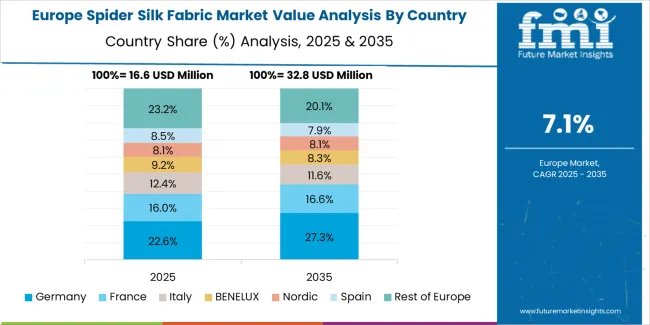
The European spider silk fabric market is projected to grow from USD 20.2 million in 2025 to USD 41.8 million by 2035, registering a CAGR of 7.6% over the forecast period. Germany is expected to maintain its leadership position with a 42.1% market share in 2025, supported by its advanced biotechnology infrastructure and major textile centers.
United Kingdom follows with a 26.3% share in 2025, driven by comprehensive luxury fashion programs and textile innovation development initiatives. France holds a 15.2% share through specialized fashion applications and design compliance requirements. Italy commands a 10.1% share, while Spain accounts for 6.3% in 2025. The rest of Europe region is anticipated to gain momentum, expanding its collective share from 4.5% to 5.1% by 2035, attributed to increasing textile adoption in Nordic countries and emerging manufacturing facilities implementing textile modernization programs.
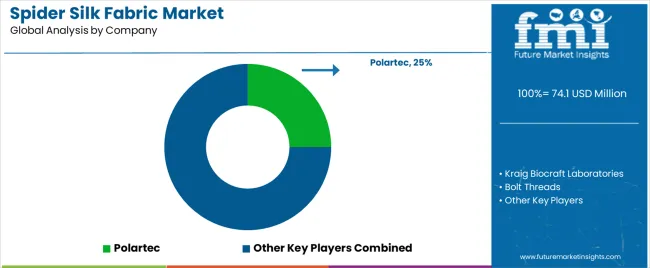
| Stakeholder | What they actually control | Typical strengths | Typical blind spots |
|---|---|---|---|
| Global platforms | Distribution reach, broad product catalogs, technical support networks | Wide availability, proven technology, multi-region support | Product refresh cycles; customer dependency on technical validation |
| Biotechnology innovators | R&D capabilities; advanced production technologies; enhanced material properties | Latest technologies first; attractive ROI on production effectiveness | Service density outside core regions; scaling complexity |
| Regional specialists | Local compliance, fast delivery, nearby technical support | "Close to site" support; pragmatic pricing; local regulations | Technology gaps; talent retention in technical support |
| Application-focused ecosystems | Material validation, application development, regulatory support | Lowest technical risk; comprehensive support | Service costs if overpromised; technology obsolescence |
| Niche specialists | Specialized applications, custom materials, research support | Win research/development applications; flexible configurations | Scalability limitations; narrow market focus |
| Item | Value |
|---|---|
| Quantitative Units | USD 74.1 million |
| Product Type | Natural Spider Silk, Synthetic Spider Silk |
| Application | Clothing, Military, Medical, Aerospace, Others |
| End Use | Fashion Brands, Defense Contractors, Medical Device Manufacturers, Aerospace Companies, Research Institutions |
| Regions Covered | North America, Latin America, Western Europe, Eastern Europe, East Asia, South Asia Pacific, Middle East & Africa |
| Countries Covered | China, India, Germany, Brazil, United States, United Kingdom, Japan, Canada, France, Australia, and 25+ additional countries |
| Key Companies Profiled | Polartec, Kraig Biocraft Laboratories, Bolt Threads, Spiber, AMSilk, Biofabricate, Modern Meadow, Qmonos, Protein Evolution, Cambridge Bioworks |
| Additional Attributes | Dollar sales by product type and application categories, regional adoption trends across East Asia, North America, and Western Europe, competitive landscape with biotechnology manufacturers and textile suppliers, textile operator preferences for material effectiveness and production reliability, integration with manufacturing platforms and quality monitoring systems, innovations in silk production and material enhancement, and development of advanced biotechnology solutions with enhanced performance and commercial optimization capabilities. |
The global spider silk fabric market is estimated to be valued at USD 74.1 million in 2025.
The market size for the spider silk fabric market is projected to reach USD 158.5 million by 2035.
The spider silk fabric market is expected to grow at a 7.9% CAGR between 2025 and 2035.
The key product types in spider silk fabric market are natural spider silk and synthetic spider silk.
In terms of application, clothing segment to command 39.9% share in the spider silk fabric market in 2025.






Full Research Suite comprises of:
Market outlook & trends analysis
Interviews & case studies
Strategic recommendations
Vendor profiles & capabilities analysis
5-year forecasts
8 regions and 60+ country-level data splits
Market segment data splits
12 months of continuous data updates
DELIVERED AS:
PDF EXCEL ONLINE
Spider Lift Market Size and Share Forecast Outlook 2025 to 2035
Spider Cranes Market Analysis based on Lifting Capacity, Operation, Control System, Application, Ownership and Region: A Forecast from 2025 to 2035
Spider Silk Fibers Market Size and Share Forecast Outlook 2025 to 2035
Synthetic Spider Silk Proteins Market Analysis - Size, Share, and Forecast Outlook 2025 to 2035
Silky Matte Film Market Size and Share Forecast Outlook 2025 to 2035
Silk Laminated Paper Market Analysis - Size, Share, and Forecast Outlook 2025 to 2035
Silk Protein Market Analysis - Sericin & Fibroin Forecast 2024-2034
Silk Market Growth – Trends & Forecast 2024-2034
Mimetic Silk Protein Formulas Market Size and Share Forecast Outlook 2025 to 2035
Hydrolyzed Silk Proteins Market Analysis - Size, Share, and Forecast Outlook 2025 to 2035
Fabric Inspection Machine Market Size and Share Forecast Outlook 2025 to 2035
Fabric Cutting Machine Market Size and Share Forecast Outlook 2025 to 2035
Fabric Testing Equipment Market Size and Share Forecast Outlook 2025 to 2035
Fabric Toys Market Size and Share Forecast Outlook 2025 to 2035
Fabric Softener Sheet Market Size and Share Forecast Outlook 2025 to 2035
Fabric Filter System Market Size & Forecast 2025 to 2035
Fabric Softener Market Analysis by Nature, Product Type, End Use, Sales Channel & Region from 2025 to 2035
Fabric Care Market Analysis - Trends, Growth & Forecast 2025 to 2035
Fabric Odor Eliminator Market – Trends, Growth & Forecast 2025 to 2035
Fabric Stain Remover Market Growth – Trends, Demand & Innovations 2025-2035

Thank you!
You will receive an email from our Business Development Manager. Please be sure to check your SPAM/JUNK folder too.
Chat With
MaRIA